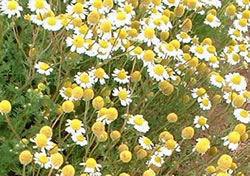Uses
Analgesic, anti inflammatory, antispasmodic, calmative, migraine, menopause. Chamomile extracts can be used as a pesticide.

Chamomile Varieties
| Name | German | Roman |
| Latin Name | Matricaria recutica | Chamaemelum nobile |
| Colour | Ink blue aging to green and then brown | Pale blue to yellow |
| Extract yield | 6.6 L/ha | 9.22 L/ha |
| kg plant material/ha | 26 400kg/ha | 26 400kg/ha |
| Plant part used | flowers | flowers |
Planting
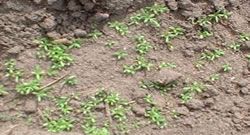
To grow chamomile, scatter the chamomile seeds on cultivated soil and do not cover them with soil but compact soil with a Cambridge roller. It grows in any type of soil, but a pH of less that 6.9 is more appropriate, likes sunny locations and a little drying out between watering. Chamomile is a very fine seed about 1.8 million seed per kg. Water thoroughly to keep evenly moist through germination then continue for the next 2 weeks after germination. It prefers full sun but will grow in partial shade as well. Germination takes 3-10 days but can take up to 3 weeks in very cold climates. Take care that the soil is well drained. Grow the plants close together so that they help support each other. Only plant in autumn in the southern hemisphere in Europe plant in early spring when frost is prevalent.
Growing
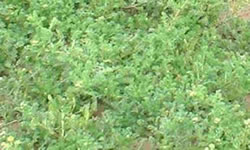
The plant grows to about 0.6m in height, it is native to Europe and northern and western Asia, and has been naturalized in Australia and North America and is extensively cultivated in South Africa, Hungary , Romania , Bulgaria , Germany , Greece , Argentina and Egypt. Slightly acidic soil (pH 6) favours growth and essential oil production, whereas alkaline soils (pH 8-9) adversely affect them. Flower heads are gathered in spring when mature or expanded. Growth is good but weeds control before harvesting. (because Autumn planting and winter growth there are very few if no weeds at all when picking in spring again in the Southern Hemisphere Please adjust for Northern Climates)
Weed Control
Single application of chlorpropham + pentanochlor, applied by tractor-mounted spray. ( please stay as natural as possible, planting in winter can prevent weeds and save the environment and money) Super Phosphate 100kg per ha before planting, 2.3.2 @ 100kg per ha, LAN and 1:0:1 @ 100 kg per ha 2weeks before flowering.
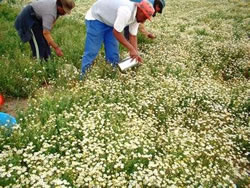
Watering and Fertilisation Schedule
| Time | Pivot % | How long? |
| 1st 3 weeks after planting | 100%, 5-7m per watering | 1 to 2 times /day depending on day time heat and evaporation |
| Week 4 to picking | 100%, 5-7m per watering, 2 to 3 times per week | As required use discretion-soil must remain moist at all times |
| Picking | once per week | As required |
Harvesting
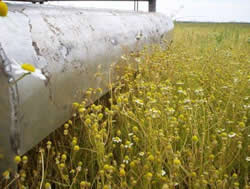
When the blooms have opened fully (the petals falling back down from the centre) flowers should be harvested. Harvest only when in full bloom. It would be best to harvest at peak rather than post-peak flowering. Usually 8-12 weeks after planting harvesting can take place. The more flowers which are picked, the more flowers will re-grow. Flowers can be picked for at least for 4-6weeks.
Drying
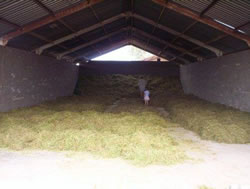
Chamomile flowers are best dried on a screen while covered lightly with a cheesecloth. Harvesting by hand yields 180kg flowers per day per worker i.e. 2 workers per ha. The extract is obtained from the dried flower heads it is dark blue in Colour. It is preferred that the flowers are dry before going through the extraction process.

 Proud to be
Proud to be